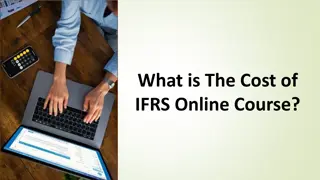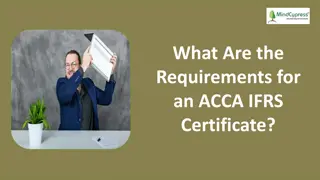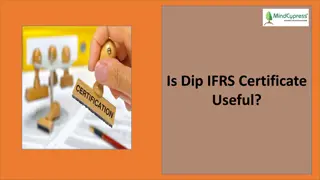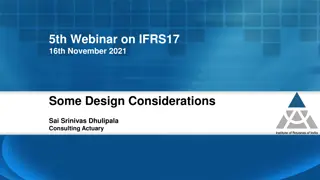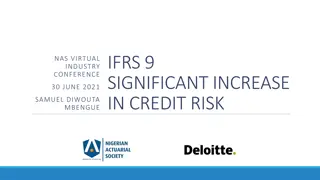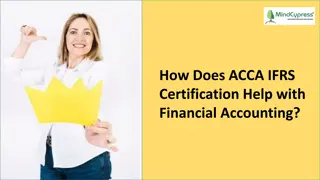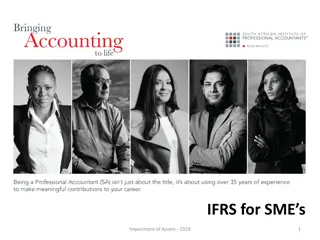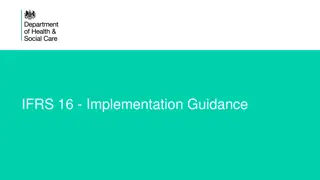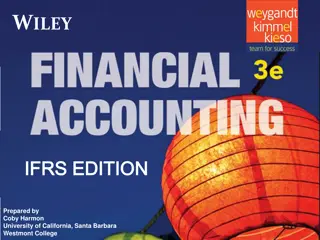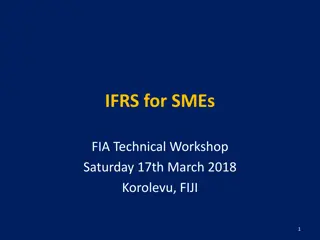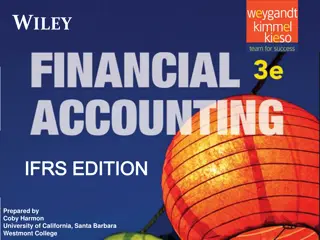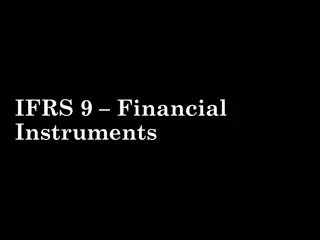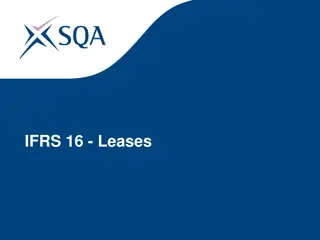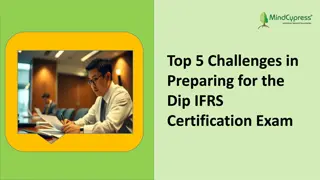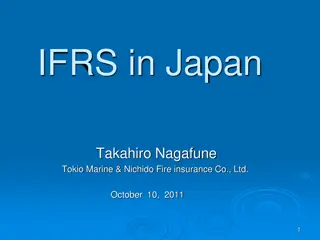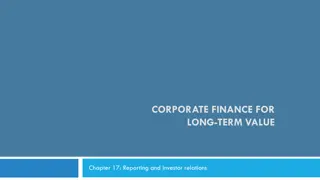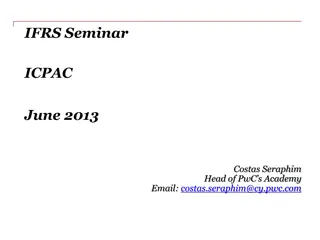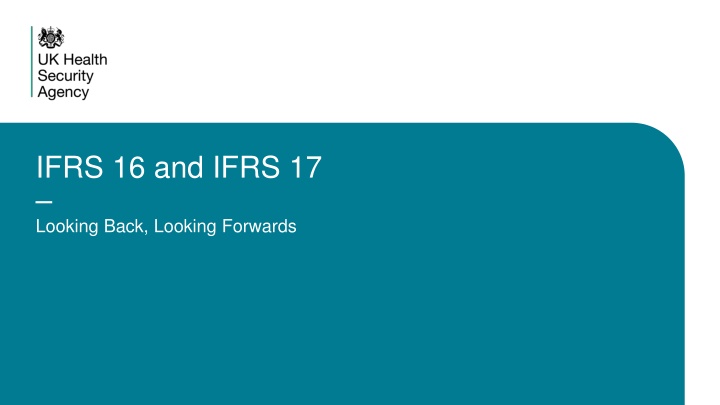
Understand IFRS 16 and IFRS 17 | Lease and Insurance Accounting Standards
Explore the impact of IFRS 16 and IFRS 17 on lease accounting and insurance contracts, including ongoing challenges and implementation processes. Learn about lease classification, valuations, and the transition to these new standards. Stay updated with the latest requirements for financial reporting in the private and public sectors.
Download Presentation

Please find below an Image/Link to download the presentation.
The content on the website is provided AS IS for your information and personal use only. It may not be sold, licensed, or shared on other websites without obtaining consent from the author. If you encounter any issues during the download, it is possible that the publisher has removed the file from their server.
You are allowed to download the files provided on this website for personal or commercial use, subject to the condition that they are used lawfully. All files are the property of their respective owners.
The content on the website is provided AS IS for your information and personal use only. It may not be sold, licensed, or shared on other websites without obtaining consent from the author.
E N D
Presentation Transcript
IFRS 16 and IFRS 17 Looking Back, Looking Forwards
IFRS 16 The standard and its implementation Identify areas for review Lease classification and valuations (inc. Peppercorns) Implement ongoing processes Finance training on the standard Review of contracts for all risk areas Postings and transition What is IFRS 16? Challenges IFRS 16 required reassessment of contracts that might be classed as leases under the standard, but which hadn t previously been appropriately identified. The leases standard: introduced in the private sector for reporting periods beginning on or after 1st Jan 2019, but delayed in the public sector until FY 22/23. IFRS 16 and 17 2
IFRS 16 Ongoing Impact Identify new leases prior to their inception needs to be at the planning stage for new contracts. IDENTIFY Planning needs to include the CapEx requirements for any leases (standard or implicit) and may need to be over 12 months ahead of execution. Lease processes should include regular review of lease liabilities to check if the value or effective length have changed. REVIEW PLAN Ensure contracts signed are in line with earlier expectations and log on lease systems.. EXECUTE IFRS 16 and IFRS 17 3
IFRS 16 Other Ongoing Impacts Ongoing measurement generally uses the cost model for RoU assets (per FReM 10.2.1) i.e. depreciate them over time, impair if required. But if you have peppercorn leases or long-term leases where costs are not uplifted, you may be required to remeasure the value of these see FReM 10.2. 01 Remeasurement of both asset and liability may be required if the lease terms change. Generally, you adjust the RoU asset and liability, but sometimes you may need to account for it as a separate lease. 02 Paragraphs 29-46 of the full standard show the requirements for remeasurement. Broadly, if the lease term changes, you update your original lease for the current terms, including remeasuring the discounting with new discount rates. 03 If it s minor changes to cost, you aren t likely to be required to remeasure the discount rate. If you add a whole additional asset/make other significant asset changes you are likely to need a new lease. Overall, unfortunately, the only answer is to read the standard. 04 IFRS 16 and IFRS 17 4
IFRS 17 Introduction What is it? Why do I care? What do I need to do? IFRS 17 is a new accounting standard for insurance contracts, replacing IFRS 4. This mainly impacts the insurance industry. Essentially, repeat the review process you completed for IFRS 16, but with IFRS 17 in mind instead. However, some contracts may have indemnities or other implicit insurance contracts in which case IFRS 17 would be applicable. It has already been implemented for the private sector, with implementation for the public sector expected in FY 25/26. However, in this instance the most likely outcome is you evidence that the impact is not material. IFRS 16 and IFRS 17 5
IFRS 17 The basics What is an insurance contract? There is no requirement for a fee to be payable. It does not apply to warranties, or financial guarantee contracts (use IFRS 9 instead for guarantees). A contract under which one party (the issuer) accepts significant insurance risk from another party (the policyholder) by agreeing to compensate the policyholder if a specified uncertain future event (the insured event) adversely affects the policyholder. It does not apply to residual value guarantees embedded in leases. It does not apply to insurance contracts where the entity is the policy holder (unless you are reinsuring an insurance risk). IFRS 16 and IFRS 17 6
IFRS 17 The basics (cont.) Applies to: Insurance contracts Reinsurance contracts A particular, very specific type of financial instrument (unlikely to apply to the NHS). Fixed fee service but meet definition of insurance contract? Providing certain conditions are met, an entity may elect to apply IFRS 15 instead. Obligation to separate out non- insurance components and account for them separately. Overall, IFRS 17 is designed to ensure profits from insurance contracts are recognised over the lifetime of the contract, while losses are recognised as soon as they are expected. IFRS 16 and IFRS 17 7
IFRS 17 The balance sheet Balance Sheet This is the expected value of the coverage liability. E.g. a 1% likelihood of a 1M pay out. It has to be discounted to reflect the time value of money, and any financial risks not accounted for in the expected value. It should also include the value of any profit expected to be received relating to future coverage (which should be released over the life of the contract). For onerous contracts (which NHS contracts are likely to be overall, as they are unlikely to attract premiums), the total expected value of the loss should be recognised at the point the contract becomes onerous. Risk adjustment can be complex there s not a set method for this. Worry about it if you have big insurance numbers you probably won t. Liability for remaining coverage. Liabilities already incurred but not yet paid. This is the expected value of the coverage costs for liabilities which have already been incurred (the coverage period is in the past) but where the claim has not yet been paid. Want more? There is an in-depth presentation here, that was prepared by the Government Actuarial Dept. It s pretty complex, but worth a look if you need more information. IFRS 16 and IFRS 17 8
IFRS 17 Income and Expenditure Income and Expenditure This is essentially the deferred premium earned. It relates to the reduction in the liability you hold for future coverage on the basis that time has passed, and that period is now shorter. Revenue relating to coverage provided in period and the release of risk adjustment. Income Claims for the period and other insurance service expenses, +/- changes to cash flows or risk adjustment relating to that period or the past. This is the P&L side of the increase in liability because of claims, and any losses. It includes changes in estimates for incurred claims (i.e. where the cash flow to fulfil was not equal to the original estimate and any losses on onerous contracts. Expenditure Unwinding of discounts (and changes in discount rates). Finance Expenses This is the cost associated with unwinding discounts. Changes in discount rates can either go through finance expenses or OCI there is a choice. This may be removed in the FReM. Changes in discount dates (optional) OCI IFRS 16 and IFRS 17 9
IFRS 17 Practical steps 02 01 05 04 03 On-going processes designed and implemented. Finance training on the standard. Classifications and working papers. Identify relevant areas; including conversations with the executive and contracts staff, as well as contingent liabilities. Consider what level of review is required to be assured there is no material impact. What about at group reporting level i.e., 300k? What? Postings ready for transition. When? April 25 31 March 25 Now! Do your reading during Summer 24. Summer 24 Autumn 24 IFRS 16 and IFRS 17 10
Further Guidance Document IFRS 17 unaccompanied standard Link https://www.ifrs.org/issued-standards/list-of-standards/ifrs-17- insurance-contracts/ https://assets.publishing.service.gov.uk/media/64afd065c033c1000d 806248/IFRS_17_Insurance_Contracts_Application_Guidance.pdf https://assets.publishing.service.gov.uk/media/652e4e3b6b6fbf0014 b757c6/An_Introduction_to_IFRS_17_Webinar_10_October_2023.p df https://www.gov.uk/government/publications/gad-webinars/gad- public-webinars https://www.hfma.org.uk/publications/ifrs-17-insurance-contracts FReM application guidance GAD Introduction to IFRS 17 Slides GAD Introduction to IFRS 17 Webinar HFMA IFRS 17 Briefing This discusses common NHS income streams and how they do or don t meet the definition of an insurance contract. IFRS 16 and IFRS 17 11


